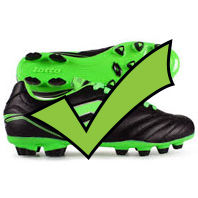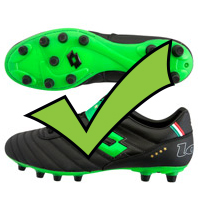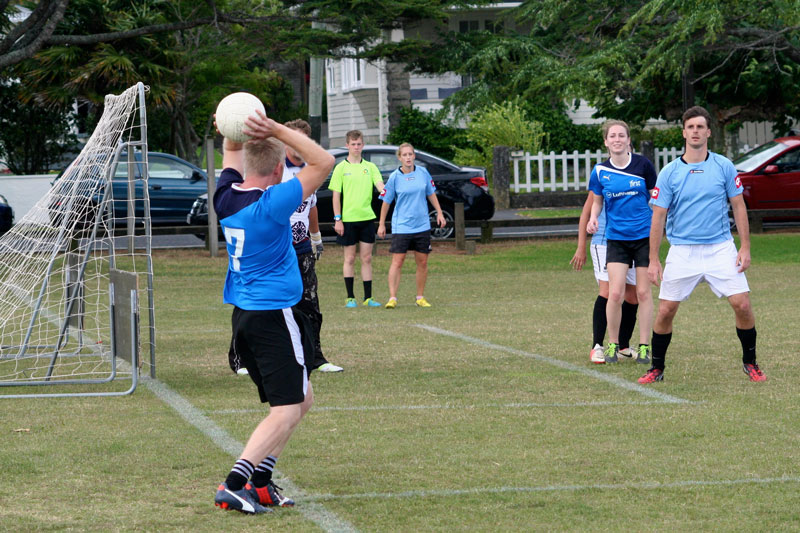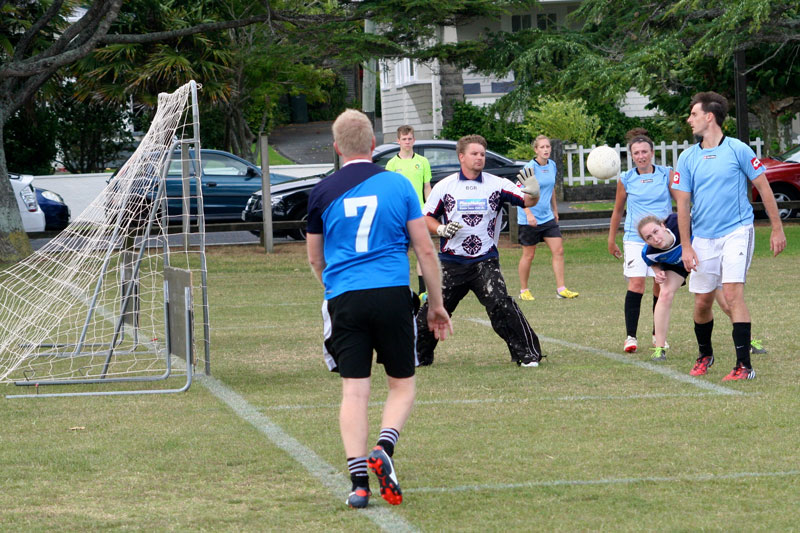HOW TO PLAY
SUB Football is a unique version of 7-a-side soccer in a fun and friendly format.
The game is designed to encourage people of all levels to play.
The main ways SUB Football differs from traditional association football/soccer are:
- Players are not permitted to use force when taking or attempting to take, or keep the ball from an opponent.
- The unique scoring system allows for a more exciting and higher scoring game, with 3 points for a goal and 1 point for a board.
- There are unlimited substitutions and no offsides
- Goalkeepers have an area that is restricted for their use only
- Players may choose to either throw or kick the ball in from the sideline
For the complete list of rules and regulations see below.
If you're a seasoned player, you should know some rules changed in 2018 and 2019. See them here.
SUB Football - How to play
Posted by SUB Football
SUB Football Rules
Last updated 25 August, 2021
Games are refereed by SUB Football qualified referees. The referee's decision is final.
Teams, Players and Apparel
1.1 Teams are 7-a-side and unlimited rolling subs are allowed. more...
- There is no need to tell the referee that you’re subbing, except in the case of the goalkeeper.
- Substitutions must enter the field at the half-way point, and the player must leave the field before the substitute comes into play. The player leaving the field may leave the field of play at the nearest sideline point.
- Failure to substitute in this manner may incur a penalty or a sin-bin to the offending substitute.
- The goalkeeper should only be substituted during a stoppage in play, and the referee informed.
1.2. Players must be at least 15 years of age.more...
- Exceptions may be made in particular competitions as listed on the SUB Football website.
- Any individual exceptions must only be with prior agreed permission directly from SUB Football organisers
1.3. Men's leagues are technically open leagues, with no gender restrictions on players.
1.4. In Mixed competitions, there must be no more than three male players on the outfield at all times. more...
- The "outfield" means all players excluding the goalkeeper.
- To field a full team of seven in a mixed competition you will need one goalkeeper (of either gender), plus at least three females.
1.5. Uniform shirts are compulsory in spring and summer leagues. more...
- Uniform shirts must be the same colour and preferably the same style and print.
- Uniform shorts and socks are not compulsory.
1.6. Goalkeepers must be identified with a different coloured shirt or bib.
1.7. Shin-pads are recommended but not compulsory. more...
- If worn, shin pads must be covered completely by socks.
1.8. Moulded sole boots or blades are the only type of football boots permitted. more...
- Screw in sprigs or metal sprigs are not permitted.



- Sneakers, turf shoes, or running shoes may be worn.
- Bare feet are not allowed.
- In the case of a player wearing incorrect footwear, the player must leave the field of play and may be substituted, but cannot return to play unless they acquire appropriate footwear.
1.9. Any jewellery deemed dangerous by the referee must be removed. more...
- Simple stud or sleeper earrings may be worn at the player’s own risk.
- Prescription glasses may be worn at the player’s own risk.
General Play
2.1. Games start at 6pm, 6:40pm and 7:20pm sharp in all leagues; additional game times may be added in autumn and winter leagues as required.
2.2. Teams require a minimum of 5 players to start. For mixed competitions, the maximum 3 males in the outfield rule still applies. more...
- Failure of a team to field a team within 5 minutes of the scheduled game start time results in a 9-0 default score.
- If your team is aware that they are unable to field a team prior to the night, the team manager should inform the venue manager – see the contact page for details.
2.3. The match ball will be provided by SUB Football.
2.4. The ball can move in any direction from kick-off. more...
- The ball must be stationary when the kick is taken and the kicker is not permitted to touch the ball a second time until it has been touched by another player.
- A goal or board may be scored from kick-off.
2.5. There are no off-sides.
2.6. An outfield player may not play at the ball with their hand or any part of their arm.more...
- Infringements of this rule will result in a free kick being awarded to the opposing team.
- If the infringement takes place in the penalty area or directly prevents a goal scoring opportunity - either by a player or a goalkeeper handling the ball outside of the goalkeeper's box, a penalty goal may be awarded to the opposing team.
2.7. Teams are awarded 3 points for a goal, and 1 point for a board. more...
- The boards flank the goal. One point is scored when the ball makes contact with the board from within the field of play.
- If you are so unlucky that the ball hits the post between the goal and the board, play continues, no points are scored.
2.8. When the ball goes out, it may be either thrown or kicked in. more...
- The ball is out when the whole ball crosses the whole line.
- The throw-in or kick-in must be taken from this point.
- A throw-in must be done so with two hands using equal force, while facing the field of play.
- Both throw-ins and kick-ins should be taken from behind the boundary line. The ball must be stationary on the ground for a kick-in.
- The delivering player is not permitted to touch the ball a second time until it has been touched by another player.
- If the ball fails to enter the field of play, it is to be re-taken.
- If a player taking a throw-in or kick-in does so incorrectly, it is to be re-taken.
- A goal or board may be scored from a throw or kick-in.
2.9. Corner kicks or throw-ins may be taken anywhere between the junction of the corner of the pitch and the edge of the penalty area. more...

-
A corner kick occurs when the ball crosses the end line off a defending player.
2.10. Free kicks are taken from where an offence is committed. more...
- The ball must be stationary when the kick is taken and the kicker is not permitted to touch the ball a second time until it has been touched by another player.
- A goal or board may be scored from a free kick.
2.11. Opposition players must stand 5m from the ball during a free-kick, at kick-off or when the ball is thrown or kicked in from the sideline.
The Goalkeeper, Goalkeepers Box Area and Penalty Area
3.1. Only the goalkeeper is allowed in the goalkeeper’s box area. more...
- The goalkeepers area is the rectangular box in front of the goal. The purpose of this box is for protection of the goalkeeper, and other players are not permitted in the area.
- A defending player may enter the box only to take a goal kick.
- If a defender enters the box in order to attempt to prevent a goal being scored, a penalty goal may be awarded to the attacking team. This includes running through the box to gain an advantage.
- If an attacking player enters the box during active play, a free kick may be awarded to the defending team.
- If a goal is scored and then the attacking player enters the box, it is at the referee’s discretion whether the goal is allowed based on whether the player made an effort to avoid entering the area.
- If any threat to the goalkeeper is thought to be posed through entering the box, the goal may be disallowed and the player may be sin binned or sent off.
3.2. The goalkeeper can handle the ball in the goalkeepers box area only. more...

- The goalkeepers box area is the rectangular box in front of the goal.
- If the goalkeeper handles the ball that is in the air but outside the box, while his feet are inside the area, it is considered a handball, and a penalty goal may be awarded. That is, it is the position of the ball that determines the offence.
- If the handball was not a game defining advantage - ie it does not prevent a goal scoring opportunity, then the attacking team may be awarded a free kick from outside the penalty area.
3.3. The goalkeeper must throw the ball into play after handling the ball. more...
- Once handled, the ball must be thrown in only; it cannot be put on the ground to then kick.
- It cannot be kicked from the hands.
3.4. Goal kicks are taken as a place kick, taken from anywhere in the goalkeepers area. more...
- A goal kick occurs when the ball crosses the end line off an attacking player.
- A goal-kick is no longer required to leave the penalty area before a teammate touches the ball, meaning once the goalkeeper touches the ball for the kick, it is immediately considered in play. Opponents must remain outside the penalty area when a goal-kick takes place.
- If an outfield player takes the place kick, they must clear the goalkeeper’s box immediately.
- The kicker shall not play the ball a second time until it has been touched or played by another player.
- Players of the attacking team shall remain outside the penalty area until the ball has been kicked by the person taking the goal-kick.
3.5. The goalkeeper cannot handle a ball deliberately passed back from a team member unless it is off the players head. more...
- If this occurs a free kick is awarded to the opposition, taken from the location where the pass-back occurred.
3.6. Any offence committed inside the penalty area or goalkeepers box area by a defending team that prevents a direct goal scoring opportunity results in a penalty goal (3 points) being awarded to the opposing team. more...
- This excludes errors associated with goal kicks or throws, in which case the goal kick or throw is to be re-taken.
- Any other offence committed inside the D should result in a free kick to the opposing team, taken from the edge of the D if awarded to the attacking team.
Fouls and Misconduct
4.1. The referee’s decision is final.
4.2. Aggressive or violent conduct, foul play, referee abuse, spitting at others, and offensive speech will not be tolerated.
4.3. A free kick or penalty may be awarded to the opposing team if a player commits any of the following offences:
- Uses force when taking or attempting to take the ball from an opponent
- Slides when taking or attempting to take the ball from an opponent
- Pushes or holds an opponent
- Handles the ball
- Plays in a dangerous manner
- Impedes the progress of an opponent
- Prevents the goalkeeper from releasing the ball from his hands
- Tackles an opponent from behind
4.4. Sin-bin offences (yellow card) include:
- unsporting behaviour
- dissent by word or action
- persistent infringement of the rules of SUB Football
- delaying the restart of play
- failure to respect the required distance when play is restarted with a free kick, corner kick or throw-in/kick-in unless the restart is taken quickly.
4.5. Sin-binned players (yellow card) must remain off the field for 5 minutes. more...
- The player can return to the field only when the referee indicates they may do so.
- A substitute player may go on for them only at the end of this time penalty.
- Two yellow cards in one game given to the same player results in an instant red card.
4.6. Sending-off offences (red card) include:
- serious foul play
- violent conduct
- spitting at an opponent or any other person
- denying the opposing team a goal or an obvious goal scoring opportunity by deliberately handling the ball (this does not apply to a goalkeeper within his own area)
- denying an obvious goal scoring opportunity to an opponent moving towards the player’s goal by an offence punishable by a free kick or a penalty goal
- using offensive, insulting or abusive language and/or gestures
- receiving a second caution in the same match
4.7. Sent-off players (red card) must leave the vicinity of the field of play and may not return to the game. more...
- The offending player and the team captain or manager must see the referee immediately to record the player’s name.
- The team must play a player short for the remainder of the game.
- The sent-off player must stand down for a minimum of one week from all SUB Football.
- The offence will be taken to the SUB Football disciplinary committee, and the player will have the chance to reply to the committee’s decision.
- In serious cases, the player will be banned from competition.
